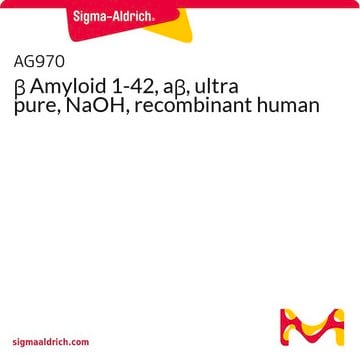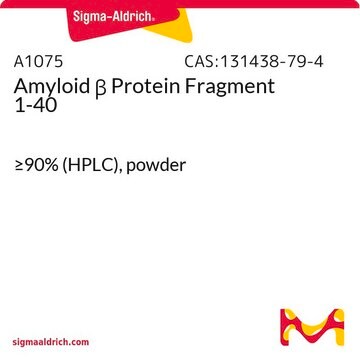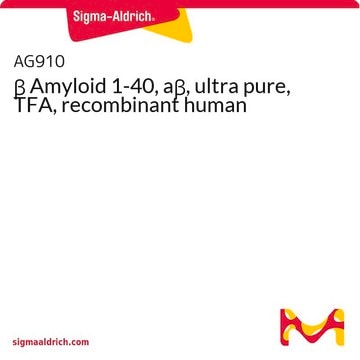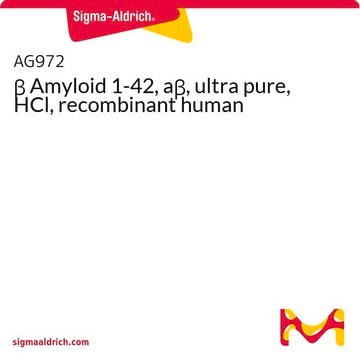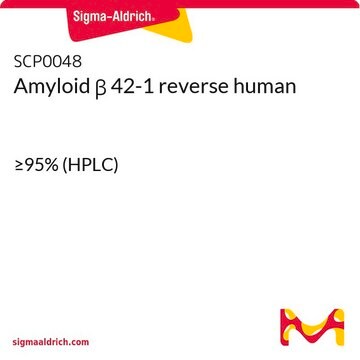AG912
β Amyloid 1-42, aβ, ultra pure, TFA, recombinant human
Sinonimo/i:
aβ peptide
Autenticatiper visualizzare i prezzi riservati alla tua organizzazione & contrattuali
About This Item
Codice UNSPSC:
12352202
eCl@ss:
32160405
NACRES:
NA.41
Prodotti consigliati
Origine biologica
human
Livello qualitativo
Saggio
>97%
Forma fisica
powder
Produttore/marchio commerciale
Chemicon®
N° accesso NCBI
N° accesso UniProt
Informazioni sul gene
human ... APP(351)
Descrizione generale
Beta Amyloid (1-42), ultra pure, TFA.
MOL. WT.: 4514.5 Da by Mass Spec Analysis (theoretical 4514.10)
SEQUENCE: H-Asp-Ala-Glu-Phe-Arg-His-Asp-Ser-Gly-Tyr-Glu-Val-His-His-Gln-Lys-Leu-Val-Phe-Phe- Ala-Glu-Asp-Val-Gly-Ser-Asn-Lys-Gly-Ala-Ile-Ile-Gly-Leu-Met-Val-Gly-Gly-Val-Val-Ile-Ala-OH
PEPTIDE CONTENT: 1 mg per vial; salt content is <10%
COUNTER ION: TFA
MOL. WT.: 4514.5 Da by Mass Spec Analysis (theoretical 4514.10)
SEQUENCE: H-Asp-Ala-Glu-Phe-Arg-His-Asp-Ser-Gly-Tyr-Glu-Val-His-His-Gln-Lys-Leu-Val-Phe-Phe- Ala-Glu-Asp-Val-Gly-Ser-Asn-Lys-Gly-Ala-Ile-Ile-Gly-Leu-Met-Val-Gly-Gly-Val-Val-Ile-Ala-OH
PEPTIDE CONTENT: 1 mg per vial; salt content is <10%
COUNTER ION: TFA
Applicazioni
Different researchers claim enhanced activity due to different salts.
The TFA salt is what has been the industry standard.
The HFIP makes the beta-amyloid homogenously monomeric.
The NaOH apparently make it monomeric too and is also water soluble, which the TFA salt and HFIP are not.
The HCl salt is supposed to be more biological, as TFA is not found in the body.
By offering the different salts, it lets the researchers duplicate the different assays that have been developed by other researchers (see below).
TFA: Shu-chuan Jao, S-C, et. al. 1997, Amyloid; Int J Exp. Clinical Invest. 4, 231
HFIP: Stine, W.B. et. al. 2003, J. Biol. Chem, 278, 11612
NaOH: Fezoui, Y., et. al. 2000, Amyloid, 7, 166
HCL: Kanek, I and Tutumi, S., 1997, J. Neurochem, 68, 438
The TFA salt is what has been the industry standard.
The HFIP makes the beta-amyloid homogenously monomeric.
The NaOH apparently make it monomeric too and is also water soluble, which the TFA salt and HFIP are not.
The HCl salt is supposed to be more biological, as TFA is not found in the body.
By offering the different salts, it lets the researchers duplicate the different assays that have been developed by other researchers (see below).
TFA: Shu-chuan Jao, S-C, et. al. 1997, Amyloid; Int J Exp. Clinical Invest. 4, 231
HFIP: Stine, W.B. et. al. 2003, J. Biol. Chem, 278, 11612
NaOH: Fezoui, Y., et. al. 2000, Amyloid, 7, 166
HCL: Kanek, I and Tutumi, S., 1997, J. Neurochem, 68, 438
Research Category
Neuroscience
Neuroscience
Research Sub Category
Neurodegenerative Diseases
Neurodegenerative Diseases
Stato fisico
White lyophilized powder. Resuspend in any one of the following solvents: 0.1% TFA, 5 mM HCl, 2 mM NaOH, 1.0 % NH4OH at a concentration of 1 mg/mL. Sonicate for 30 seconds to 1 minute after it has gone into solution. To bring into your solution: After resuspension, add 5x or 10x buffer stock (PBS, TBS) and water to bring to 1x buffer.
Stoccaggio e stabilità
Maintain lyophilized material at -20ºC for up to 12 months after date of receipt. After reconstitution maintain at -20ºC to -70ºC for up to 2 weeks in undiluted aliquots. Avoid freeze/thaw cycles to avoid aggregation.
Note legali
CHEMICON is a registered trademark of Merck KGaA, Darmstadt, Germany
Esclusione di responsabilità
Unless otherwise stated in our catalog or other company documentation accompanying the product(s), our products are intended for research use only and are not to be used for any other purpose, which includes but is not limited to, unauthorized commercial uses, in vitro diagnostic uses, ex vivo or in vivo therapeutic uses or any type of consumption or application to humans or animals.
Codice della classe di stoccaggio
11 - Combustible Solids
Classe di pericolosità dell'acqua (WGK)
WGK 1
Punto d’infiammabilità (°F)
Not applicable
Punto d’infiammabilità (°C)
Not applicable
Certificati d'analisi (COA)
Cerca il Certificati d'analisi (COA) digitando il numero di lotto/batch corrispondente. I numeri di lotto o di batch sono stampati sull'etichetta dei prodotti dopo la parola ‘Lotto’ o ‘Batch’.
Possiedi già questo prodotto?
I documenti relativi ai prodotti acquistati recentemente sono disponibili nell’Archivio dei documenti.
I clienti hanno visto anche
Yu-Kai Huang et al.
International journal of molecular sciences, 23(23) (2022-12-12)
The occurrence of Alzheimer's disease has been associated with the accumulation of beta-amyloid (β-amyloid) plaques. These plaques activate microglia to secrete inflammatory molecules, which damage neurons in the brain. Thus, understanding the underlying mechanism of microglia activation can provide a
Erdinç Dursun et al.
Dementia and geriatric cognitive disorders, 36(1-2), 76-86 (2013-06-12)
The beta amyloid aggregations present in Alzheimer's disease affect neurons through various toxic alterations. The aim of this study was to determine the expression of the vitamin D receptor (VDR), 25-hydroxyvitamin D3 24-hydroxylase (an accelerator of vitamin D catabolism), and
Il team dei nostri ricercatori vanta grande esperienza in tutte le aree della ricerca quali Life Science, scienza dei materiali, sintesi chimica, cromatografia, discipline analitiche, ecc..
Contatta l'Assistenza Tecnica.


